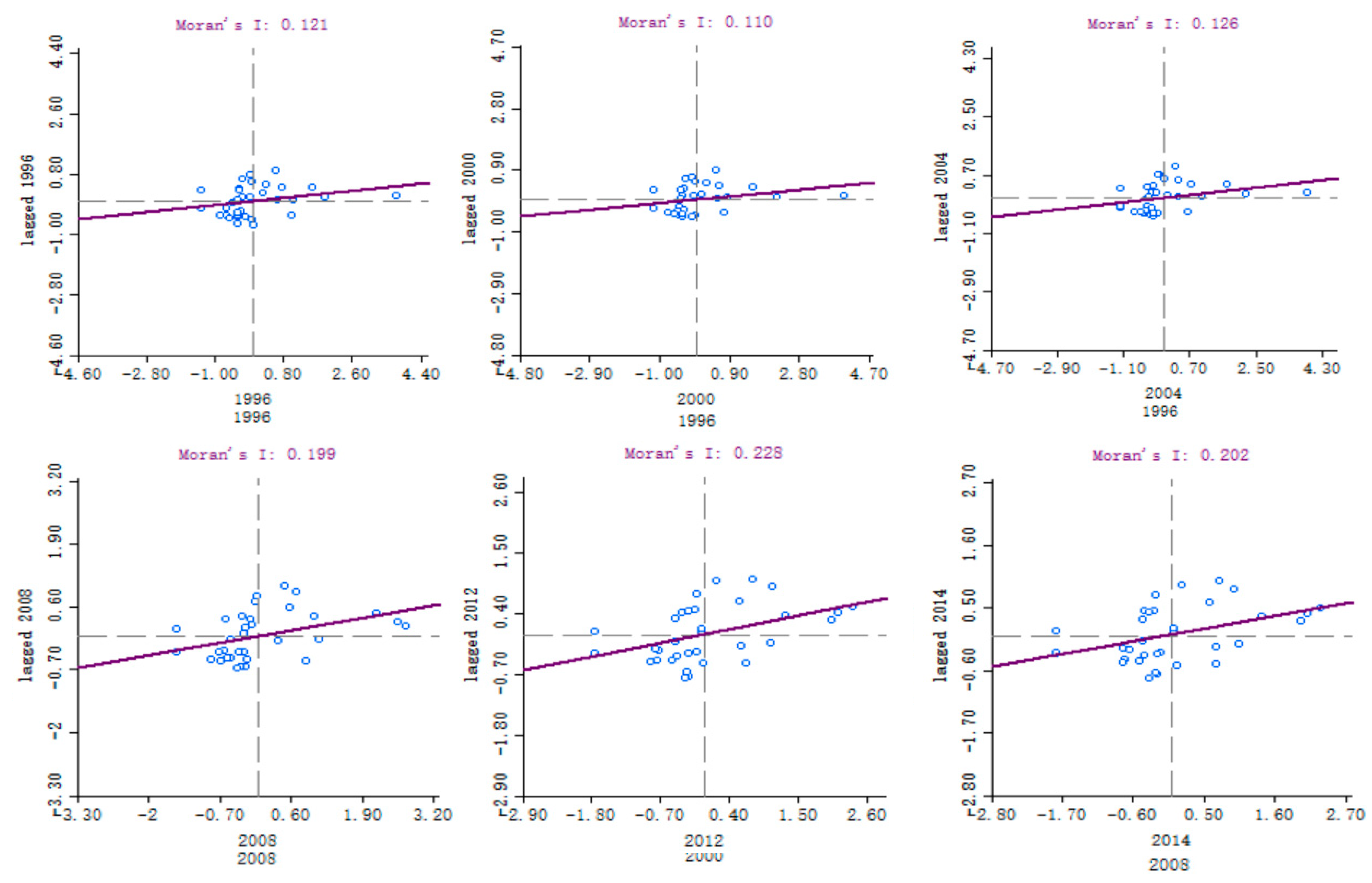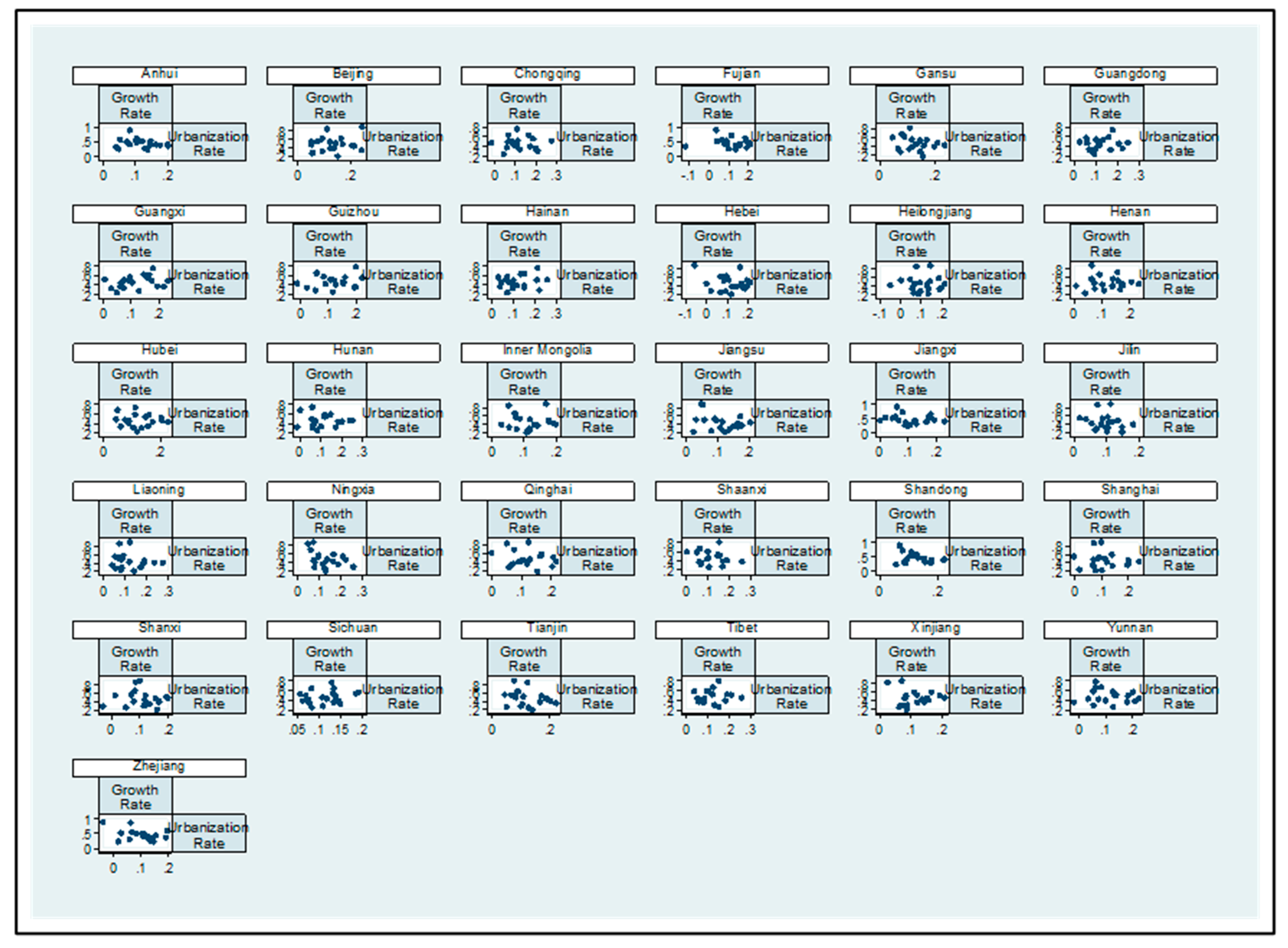The Educational Level of Rural Labor, Population Urbanization, and Sustainable Economic Growth in China
Abstract
:1. Introduction
2. Literature Review and Research Hypothesis
2.1. Urbanization and Economic Growth
2.2. Rural Education and the Effectiveness of Urbanization
3. Research Design
3.1. Modeling and Identification Strategy
3.2. Data Collection
4. Empirical Results and Discussion
4.1. How Population Urbanization Drives Economic Growth
4.2. Impact of Rural Education on Urbanization Effectiveness
4.3. Population Urbanization Without Economic Growth
5. Conclusions
Author Contributions
Funding
Conflicts of Interest
References
- State Statistical Bureau (SSB). China Statistical Yearbook; China Statistical Publishing House: Beijing, China, 2018. [Google Scholar]
- Economic Daily. China Economy Net. 2019. Available online: http://www.ce.cn/xwzx/gnsz/gdxw/201910/15/t20191015_33352515.shtml (accessed on 6 May 2020).
- Wang, X.L.; Xia, X.L. Optimizing the size of cities to promote economic growth. Econ. Res. 1999, 9, 22–29. [Google Scholar]
- Xie, D. Why does China’s population urbanization lag behind spatial urbanization: A perceptive of Chinese-style decentralization. J. Guangdong Univ. Financ. Econ. 2016, 91–101. [Google Scholar]
- Fay, M.; Opal, C. Urbanization Without Growth: A Not So Uncommon Phenomenon. 2000. Available online: http://documents.Worldbank.org/curated/en/287181468741917609/12252232220041117142056/additional/multi-page.pdf (accessed on 6 May 2020).
- UN, Department of Economic and Social Affairs, Population Facts. [EB/OL]. Available online: http://www.un.org/esa/population/publications/WUP2005/2005wup.htm,2010-12-18 (accessed on 30 May 2020).
- Ciccone, A.; Hall, R.E. Productivity and the Density of Economic Activity. Am. Econ. Rev. 1996, 86, 1. [Google Scholar]
- Henderson, J. The Effects of Urban Concentration on Economic Growth. NBER Working Papers with Number7503. 2000. Available online: https://www.nber.org/papers/w7503.pdf (accessed on 12 June 2020).
- Alberto, F.; Edward, A. Trade and Circuses:Explaining Urban Giants. Q. J. Econ. 1995, 110, 1. [Google Scholar]
- Tian, X.Y. Warning against the “Latin American trap” in population urbanization. Macroecon. Res. 2006, 2, 12–17. [Google Scholar]
- Gao, Q.; Dong, Q.J.; Shi, L. The process, characteristics, experience and enlightenment of rural urbanization in Brazil. World Agric. 2006, 4, 36–38. [Google Scholar]
- Berry, B.J. Internal structure of the city. Law Contemp. Probl. 1965, 30, 111–119. [Google Scholar] [CrossRef]
- Black, D.; Henderson, J.V. A theory of urban growth. J. Political Econ. 1999, 107, 252–284. [Google Scholar] [CrossRef]
- Bertinelli, L.; Black, D. Urbanization and growth. J. Urban Econ. 2004, 56, 81–98. [Google Scholar] [CrossRef]
- Lucas, R.E. On the mechanics of economic development. J. Monet. Econ. 1988, 49, 783–792. [Google Scholar] [CrossRef]
- Romer, P.M. Increasing returns and Long-Run Growth. J. Political Econ. 1986, 94, 1002–1037. [Google Scholar] [CrossRef] [Green Version]
- Shen, K.R.; Jiang, R. An empirical study on the influence mechanism of urbanization on economic growth in China. Stat. Res. 2007, 6, 9–15. [Google Scholar]
- Duan, R.J.; An, H.S. Econometric analysis of the relationship between urbanization and economic growth in China. Explor. Econ. Probl. 2009, 3, 26–30. [Google Scholar]
- Lv, J. Spatial econometric analysis of urbanization driving economic growth: 2000–2009. Shanghai Econ. Res. 2011, 5, 3–15. [Google Scholar]
- Nie, H.L.; Han, Y.; Qian, L. A comparative study of population urbanization and economic growth dynamics in China based on panel data. Soft Sci. 2012, 5, 27–31. [Google Scholar]
- Shen, J.; Feng, Z.; Wong, K.Y. Dual-track urbanization in a transitional economy: The case of Pearl River Delta in South China. Habitat Int. 2016, 30, 690–705. [Google Scholar] [CrossRef]
- Wei, X.H.; Wang, Y.L. Urbanization, innovation, and total factor productivity growth—Empirical research based on inter-provincial panel data. Financ. Sci. 2010, 3, 69–76. [Google Scholar]
- Liu, H.L. Population urbanization, urban-rural income gap and consumer demand—An empirical analysis based on inter-provincial panel data. Popul. Econ. 2013, 6, 63–70. [Google Scholar]
- Schultz, T.W. Investment in human beings. J. Political Econ. 1962, 72, 5. [Google Scholar]
- Atchoarena, D.; Gasperini, L. Education for rural development: Towards new policy responses. Int. Inst. Educ. Plan. (IIEP) Unesco 2003, 25, 180–181. [Google Scholar]
- Forget, E. A tale of two communities: Fighting poverty in the great society (1964-68). Hist. Political Econ. 2011, 43, 199–223. [Google Scholar] [CrossRef]
- Champion, T. Urbanization, Suburbanization, Counter-Urbanization and Re-Urbanization. Handb. Urban Stud. 2001, 143–160. [Google Scholar]
- Holden, L.; Biddle, J. The introduction of human capital theory into education policy in the United States. Hist. Political Econ. 2016, 49, 537–574. [Google Scholar] [CrossRef]
- Zou, W.; Zhang, F. The income gap and the accumulation of human capital in rural China. Chin. Soc. Sci. 2006, 26, 67–79. [Google Scholar]
- Yan, X.H. Empirical analysis of the relationship between urbanization level and long-term economic growth --Based on panel data from 27 provinces. Economics 2011, 3, 25–28. [Google Scholar]
- Xiong, C.; Gao, H. Research on the disharmony between population urbanization and spatial urbanization--Based on the perspective of fiscal decentralization. Res. Political Econ. 2013, 1, 173–185. [Google Scholar]
- Kong, X.; Deng, F. An empirical analysis of the population urbanization effect on the economic growth in China. Popul. Econ. 2015, 6, 32–42. [Google Scholar]
- Zhou, G.; Luo, S. Higher education input, technological innovation, and economic growth in China. Sustainability 2018, 10, 2615. [Google Scholar] [CrossRef] [Green Version]
- Chan, K.W.; Zhang, L. The hukou system and rural-urban migration in China: Processes and changes. China Q. 1999, 160, 818–855. [Google Scholar] [CrossRef] [PubMed] [Green Version]
- Chen, Y. The problems of rural education brought by urbanization. Fujian Forum (Humanit. Soc. Sci.) 2007, S1, 237–238. [Google Scholar]
- Xu, S.; Law, W.W. Rural education and urbanization: Experiences and struggles in China since the late 1970’s. Glob. Educ. Rev. 2015, 2, 78–100. [Google Scholar]
- Arnold, M.L. Rural education: A new perspective is needed at the U.S. Department of Education. J. Res. Rural Educ. 2005, 20, 1–3. [Google Scholar]



| Variables | Measurement | Observations | Mean | Std.Dev | Min | Max |
|---|---|---|---|---|---|---|
| GDP per capita (PGDP) | Total GDP in one province/total population (yuan) | 560 | 22,294.78 | 19,701.38 | 2199 | 105,231 |
| Urbanization Rate (Urbanization) | Urbanization population/total population (%) | 560 | 0.445 | 0.167 | 0.140 | 0.896 |
| Consumption Ability (Consumption) | Total consumption of urban residents/total urban population (yuan) | 560 | 2303.43 | 2982.95 | 16.13 | 21,913.9 |
| Industrial Structure (Industry) | Output value of the secondary and Tertiary Industry/total GDP (%) | 560 | 0.857 | 0.076 | 0.62 | 1 |
| Technology Innovation (Innovation) | The total number of patent in each province | 560 | 5670.43 | 11,511.19 | 512 | 126,936 |
| Rural Education (Rural-EDU) | The average schooling year of the rural labor (year) | 560 | 7.714 | 1.264 | 2.228 | 10.582 |
| OLS | |||||
| Model I | Model II | Model III | Model IV | Model V | |
| LnPGDP | LnPGDP | LnPGDP | LnPGDP | LnPGDP | |
| Urbanization | 1.739 *** (0.133) | 0.078 (0.138) | 0.865 *** (0.119) | 1.687 *** (0.140) | −0.119 (0.121) |
| Consumption(H1) | 0.476 *** (0.026) | 0.369 *** (0.023) | |||
| Industry (H2) | 3.815 *** (0.217) | 2.839 *** (0.195) | |||
| Innovation (H3) | 0.015 (0.013) | −0.010 (0.009) | |||
| ρ | 0.776 *** (0.015) | 0.435 *** (0.024) | 0.700 *** (0.014) | 0.774 *** (0.016) | 0.449 *** (0.021) |
| Observations | 558 | 558 | 558 | 555 | 555 |
| R-adj | 0.66 | 0.49 | 0.70 | 0.62 | 0.42 |
| logL | 210.25 | 361.94 | 337.95 | 210.96 | 451.75 |
| LM spatial lag | 55.24 (p = 0.00) | 56.25 (p = 0.00) | 55.23 (p = 0.00) | 55.64 (p = 0.00) | 55.29 (p = 0.00) |
| LM spatial error | 36.51 (p = 0.00) | 41.25 (p = 0.00) | 37.46 (p = 0.00) | 36.74 (p = 0.00) | 40.35 (p = 0.00) |
| Wald test spatial error | 89.24 (p = 0.00) | 88.35 (p-0.00) | 89.03 (p = 0.00) | 89.71 (p = 0.00) | 88.24 (p = 0.00) |
| Model | SAR | SAR | SAR | SAR | SAR |
| SYS-GMM | |||||
| Model I | Model II | Model III | Model IV | Model V | |
| LnGDP(−1) | 0.954 *** (0.006) | 0.823 *** (0.011) | 0.918 *** (0.006) | 0.953 *** (0.006) | 0.810 *** (0.012) |
| Urbanization | 0.644 *** (0.056) | 0.482 *** (0.053) | 0.220 *** (0.064) | 0.624 *** (0.056) | 0.120 (0.062) |
| Consumption(H1) | - | 0.128 *** (0.010) | - | - | 0.109 *** (0.010) |
| Industry (H2) | - | - | 1.783 *** (0.135) | - | 1.588 *** (0.128) |
| Innovation (H3) | - | - | 0.007 (0.003) | 0.002 (0.003) | |
| Sargan test | (0.17) | (0.53) | (0.35) | (0.34) | (0.51) |
| Observations | 527 | 527 | 527 | 527 | 527 |
| Model VI | Model VII | Model VIII | Model IX | Model X | |
|---|---|---|---|---|---|
| Ln(PGDP) | Consumption | Ln(PGDP) (H4a) | Industry | Ln(PGDP) (H4b) | |
| Urbanization | 3.455 *** (0.932) | 0.782 (0.909) | 0.316 (0.942) | 0.845 *** (0.069) | −1.840 (2.806) |
| Rural-EDU | 0.598 *** (0.066) | 0.498 *** (0.064) | −0.018 (0.046) | 0.063 *** (0.005) | −0.230 (0.266) |
| Urbanization*Rural-EDU | 0.142 (0.114) | 0.607 *** (0.111) | 0.171 * (0.122) | −0.077 *** (0.021) | 0.544 (0.356) |
| Consumption | - | - | 0.977 *** (0.101) | - | - |
| Consumption*Rural-EDU | - | - | −0.031 (0.012) | - | - |
| Industry | - | - | - | - | 4.507 * (1.922) |
| Industry*Rural-EDU | - | - | - | - | 0.509 (0.353) |
| Constant | 2.994 *** (0.447) | 0.673 (0.434) | 3.896 *** (0.351) | 0.269 *** (0.033) | 3.056 ** (1.068) |
| MODEL | Fixed | Fixed | Random | Fixed | Fixed |
| Observations | 558 | 558 | 558 | 558 | 558 |
| R-adj | 0.57 | 0.50 | 0.65 | 0.37 | 0.67 |
© 2020 by the authors. Licensee MDPI, Basel, Switzerland. This article is an open access article distributed under the terms and conditions of the Creative Commons Attribution (CC BY) license (http://creativecommons.org/licenses/by/4.0/).
Share and Cite
Cao, S.; Yu, N.; Wu, Y.; Wang, Z.; Mi, J. The Educational Level of Rural Labor, Population Urbanization, and Sustainable Economic Growth in China. Sustainability 2020, 12, 4860. https://doi.org/10.3390/su12124860
Cao S, Yu N, Wu Y, Wang Z, Mi J. The Educational Level of Rural Labor, Population Urbanization, and Sustainable Economic Growth in China. Sustainability. 2020; 12(12):4860. https://doi.org/10.3390/su12124860
Chicago/Turabian StyleCao, Shu, Nannan Yu, Yang Wu, Zihe Wang, and Jianing Mi. 2020. "The Educational Level of Rural Labor, Population Urbanization, and Sustainable Economic Growth in China" Sustainability 12, no. 12: 4860. https://doi.org/10.3390/su12124860
APA StyleCao, S., Yu, N., Wu, Y., Wang, Z., & Mi, J. (2020). The Educational Level of Rural Labor, Population Urbanization, and Sustainable Economic Growth in China. Sustainability, 12(12), 4860. https://doi.org/10.3390/su12124860




